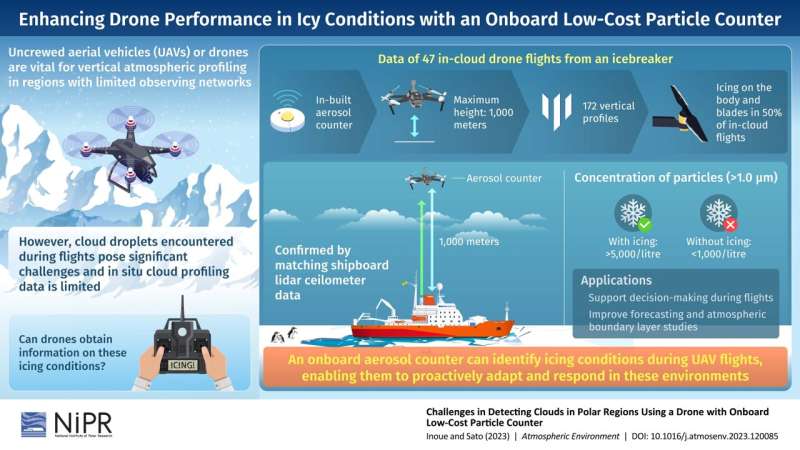This article has been reviewed according to Science X's editorial process and policies. Editors have highlighted the following attributes while ensuring the content's credibility:
fact-checked
peer-reviewed publication
proofread
Enhancing the safety and efficacy of drone flights in polar regions

Collecting accurate weather data in remote and challenging environments like the polar regions and mountains can be extremely difficult. These areas often lack the infrastructure and resources needed for traditional weather stations, and the harsh weather conditions can make it dangerous for humans to access and maintain these stations.
Drones can navigate these challenging terrains, gather data, and transmit it to researchers, making them an indispensable tool for addressing these data gaps. Unfortunately, in-cloud flights still pose a challenge, with icing from supercooled cloud droplets that can damage vital drone components, rendering them inoperable.
To solve this problem, Drs. Jun Inoue and Kazutoshi Sato from the National Institute of Polar Research, Japan, came together to devise a creative solution: they integrated onboard aerosol counters into a group of drones used during the Japanese Antarctic Research Expedition of 2022/2023.
The study is published in Atmospheric Environment.The scientists used the aerosol counters, which are typically used to measure the concentration of particles in the air, to detect the presence of clouds during drone flights.
"Under usual conditions in our expedition, we typically observe concentrations of fewer than a thousand particles per liter," explained Dr. Jun Inoue. "However, when we encounter icing conditions, we see concentrations of 5,000 particles per liter or even higher." This change enables the drones to promptly detect and respond to hazardous conditions in real-time.
During meteorological vertical profiling, which involves the information of atmospheric conditions at different altitudes, the drones do not need to travel far horizontally, making it easier to decide when to descend in icing conditions. The aerosol counter plays a pivotal role in this scenario, as it empowers drone operators to make informed decisions promptly.
To further confirm the reliability of this method, the scientists compared the counters' observations with data collected from a shipboard lidar ceilometer. The ceilometer provides critical information about cloud properties, such as their height and whether they consist of water or ice.
The authors examined the attenuated backscatter coefficient, which indicates how light bounces off the clouds, and were able to establish a clear connection between the increased particle counts detected by the aerosol counter based on 47 in-cloud flights and the presence of supercooled liquid clouds.
The counters successfully detect icing conditions among half of the in-cloud flights, which reached heights of approximately 1,000 meters above the sea level. This information helped the drones avoid flying through dangerous icing conditions.
Drones can be a valuable tool for studying the atmosphere, especially in places like the polar regions, and these findings can improve our understanding of clouds and weather. "With continued innovation and collaboration, drones can revolutionize meteorological research, ultimately benefiting our comprehension of clouds, weather, and their broader implications," Dr. Inoue concludes.
More information: Jun Inoue et al, Challenges in Detecting Clouds in Polar Regions Using a Drone with Onboard Low-Cost Particle Counter, Atmospheric Environment (2023). DOI: 10.1016/j.atmosenv.2023.120085
Journal information: Atmospheric Environment
Provided by Research Organization of Information and Systems





















